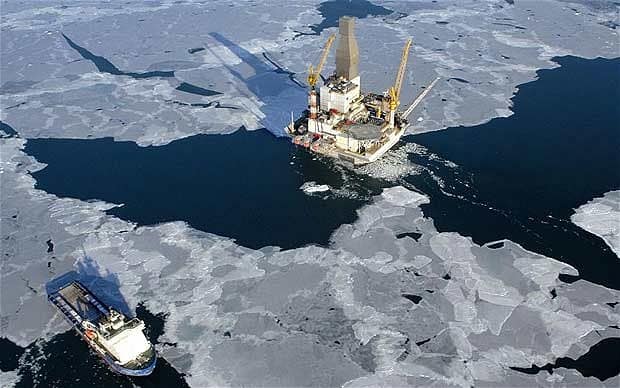Barack Obama bans oil and gas drilling in most of Arctic and Atlantic oceans
Barack Obama has permanently banned new oil and gas drilling in most US-owned waters in the Arctic and Atlantic oceans, a last-ditch effort to lock in environmental protections before he hands over to Donald Trump.
Obama used a 1953 law that allows presidents to block the sale of new offshore drilling and mining rights and makes it difficult for their successors to reverse the decision.
If you are an environmentalist or happen to actually care about climate change, then this will indeed be very good news, but if you are a “drill-baby-drill” Trump supporter … not so much.
It is of course the right thing to do, not just for the environment but for the entire planet. Climate Change is real and unless we continue to rapidly move towards a zero carbon economy then we will face catastrophic change. There was a real plan for deep decarbonisation issued by the White House a few weeks ago, but that is not part of Mr Trumps vision. It does however very much toss a spanner into the machinery behind Mr Trumps oil-based vision for the future.
But Trump will just roll this back … right?
Perhaps the most immediate thought on all of this is that in a few weeks Obama will be gone and Trump will instead sit in the White House. The most obvious questions to ask is this – What stops Trump from rolling back the ban, is this not a pointless exercise?
Obama is not daft, and obviously that rather distinct probability will have been thought through.
Let’s explore this a bit so that you can appreciate just what a smart move it actually is.
What is the Legal Basis for the Ban?
It goes back to 1948 and no less an individual than Harry S Truman himself. He issued a declaration concerning offshore oil and gas that runs as follows…
…Whereas the Government of the United States of America, aware of the long range world-wide need for new sources of petroleum and other minerals, holds the view that efforts to discover and make available new supplies of these resources should be encouraged; …
… I, Harry S. Truman, President of the United States of America, do hereby proclaim the following policy …
…the Government of the United States regards the natural resources of the subsoil and sea bed of the continental shelf beneath the high seas but contiguous to the coasts of the United States as appertaining to the United States, subject to its jurisdiction and control.
This was ratified.
The point was this – it granted the Federal Government full and final ownership and established that it was not the individual states on the coast who determined what happened offshore.
However, later in 1953 Congress attempted to row that back a bit with the adoption of the Continental Outer Shelf Lands Act. That did however delegate specific congressional rights to the President, it permitted him (or her) to sell leases to drill offshore.
OK, that sounds fine, so far not big deal. The secret sauce here is that the 1953 law also contains a specific provision that is worded as follows …
The President of the United States may, from time to time, withdraw from disposition any of the unleased lands of the outer Continental Shelf.
So Trump can simply roll it back and start selling leases?
Actually no, because legally that clause empowers the US President to put in place a permanent ban. Since it contains no provision for undoing that ban it is in effect legally one way.
Has this been used before?
Actually, yes it has. In the late 50’s Eisenhower blocked drilling in a 75 mile area off Florida.
Can it Actually be undone?
The consensus within the legal community is that it would take an act of Congress to roll the ban back.
“I think it was quite a realistic thing that Obama did, and it should be upheld—but who knows,” – John Leshy, former solicitor general to the Department of the Interior
“I don’t think those designations by President Obama are going to be that easily undone, President Trump couldn’t just come in and unilaterally undo it, because it’s a delegated authority from Congress to deal with federal property. I think the strongest interpretation is that, since the authority to create the reservation came from Congress, it would take an act of Congress to undo it” – Robin Kundis Craig, professor of law at the University of Utah and a leading expert in modern water law.
Since the Republicans clearly hold a wholly dominant position in Congress, it sounds like a done deal, they will simply roll it back … right?
Well …. and this is they key to all this … for Congress to do this, they would also need to get a law overturning this through the Senate. Yes, the Republicans do also have a majority there but it is not large enough, the Democrats hold enough seats to filibuster it.
Not quite everything offshore
There is a but of a get-out clause here. The 1953 law has a legally defined definition for the term “outer continental shelf,”. It stipulates that it starts three miles off the shore and extends to the 200-mile international-waters boundary, so technically drilling offshore is still an option if they stay within three miles of shore.
The Oil Industry Reaction is not a surprise
A spokesman for the oil industry is quoted in the Guardian article as follows …
“We are hopeful the incoming administration will reverse this decision as the nation continues to need a robust strategy for developing offshore and onshore energy.”
… and so for the reasons I’ve outlined, that, thankfully, is not going to happen very easily, if at all.
